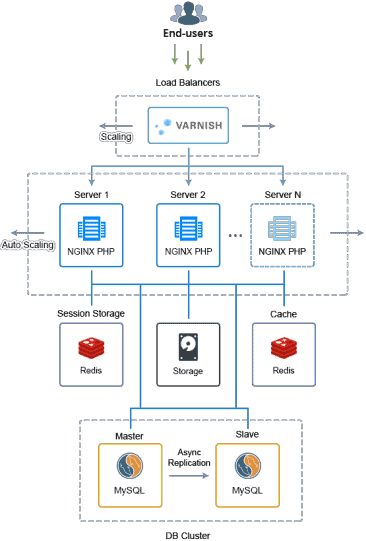Magento is an extremely popular open source e-commerce service powered by PHP. It provides a flexible modular architecture enhanced with agile ecosystem to continually adapt, customize and extend your platform. This allows Magento to be much more versatile than most e-commerce platforms at storing a large range of data.
With GPUonCLOUD PaaS, you can not just integrate Magento instance to the platform but also get a clustered solution out-of-the-box. So, let’s have a better insight into these options:
-
one-click automated installation
- manual deployment
Magento Cluster Automatic Installation
You can have a reliable and auto-scalable Magento Cluster solution for e-commerce websites up and running within minutes using the one-click installation package. If you already registered at GPUonCLOUD PaaS, it can be installed directly from your dashboard using GPUonCLOUD Marketplace.
If you don’t have an account, you can automatically get it and, simultaneously, initiate Auto-Scalable Magento Cluster solution installation – just click the Get it hosted now button below and fill the form within the opened page.
As a result, you’ll get a new environment with the following topology:

Read the Auto-Scalable Magento Cluster article for the detailed description or check the project repository at GitHub.
Instruction on Manual Magento Installation
In case you are intended to gain the full control over non-clustered Magento installation, we also prepared the detailed guide on its manual deployment. Follow the step-by-step instruction below to get your PHP Magento application inside GPUonCLOUD PaaS:
Create Environment
1. Log in to your GPUonCLOUD account and click New Environment at the top left corner of the dashboard:
2. Within the opened topology wizard, switch to the PHP tab, add the Apache application server and the MySQL database.

Note: MySQL 8 is not supported by Magento. Also, PHP 7.2.x is supported starting with the 2.3 release (currently in development).
Configure other parameters up to your needs (e.g. cloudlets limit or region) and click Create.
3. After creation, click the Config button next to your Apache server to check if the appropriate modules are activated.

4. Navigate to the /etc/php.ini file, locate and uncomment the following extensions as it is shown in the image below:
-
extension=gd.so
-
extension=xsl.so
- extension=soap.so

5. Save file and Restart nodes to apply changes.

Upload Application
1. Add Magento repository from GitHub to the Deployment Manager.
https://github.com/magento/magento2.git

2. Deploy Magento package into your environment.
For the automatic dependencies installation, expand the Hooks section and add the Post script, which will run the Composer tool from your project directory:
cd $WEBROOT/ROOT
composer install

Tip: You can adjust the Branch field to provide the exact version of Magento (e.g. we set the 2.2.6 tag as the latest stable one at the moment).
In a minute your Magento project will be deployed.
Configure Database
- While your project is deployed and dependencies installed, you can create a dedicated database with user. Click the Open in Browser button for your MySQL node.
 2. Log in with credentials you’ve received via email after environment creation. Switch to the User accounts tab and click the Add user account link.
2. Log in with credentials you’ve received via email after environment creation. Switch to the User accounts tab and click the Add user account link.

3. Provide the desired User name and Password for your new account.
-
Tick the Create database with same name and grant all privileges option and click Go at the bottom of the page.
Install Magento
1. Click the Open in Browser button for your application server.

2. The process of installation is rather simple, just follow the displayed steps.

3. Let’s pay attention to the Add a Database step. Fill in the fields by specifying your database host (for example can be seen in the appropriate email) and credentials of a user created in the previous section:
4. Configure your Magento installation through the other steps and click Install Now on the last one to proceed.
Tip: On the first connection to admin panel, you may see some warning notifications at the top of the admin panel:
-
invalid indexers – run the next command php $WEBROOT/ROOT/bin/magento indexer:reindex command via Web SSH to reindex
- invalidated cache – select the appropriate cache (e.g. Page Cache) and refresh it via admin panel
That’s all! Now you can start working with Magento in GPUonCLOUD PaaS.
Tip: On the first connection to admin panel, you may see some warning notifications at the top of the admin panel:
-
invalid indexers – run the next command php $WEBROOT/ROOT/bin/magento indexer:reindex command via Web SSH to reindex
- invalidated cache – select the appropriate cache (e.g. Page Cache) and refresh it via admin panel
That’s all! Now you can start working with Magento in GPUonCLOUD PaaS.

